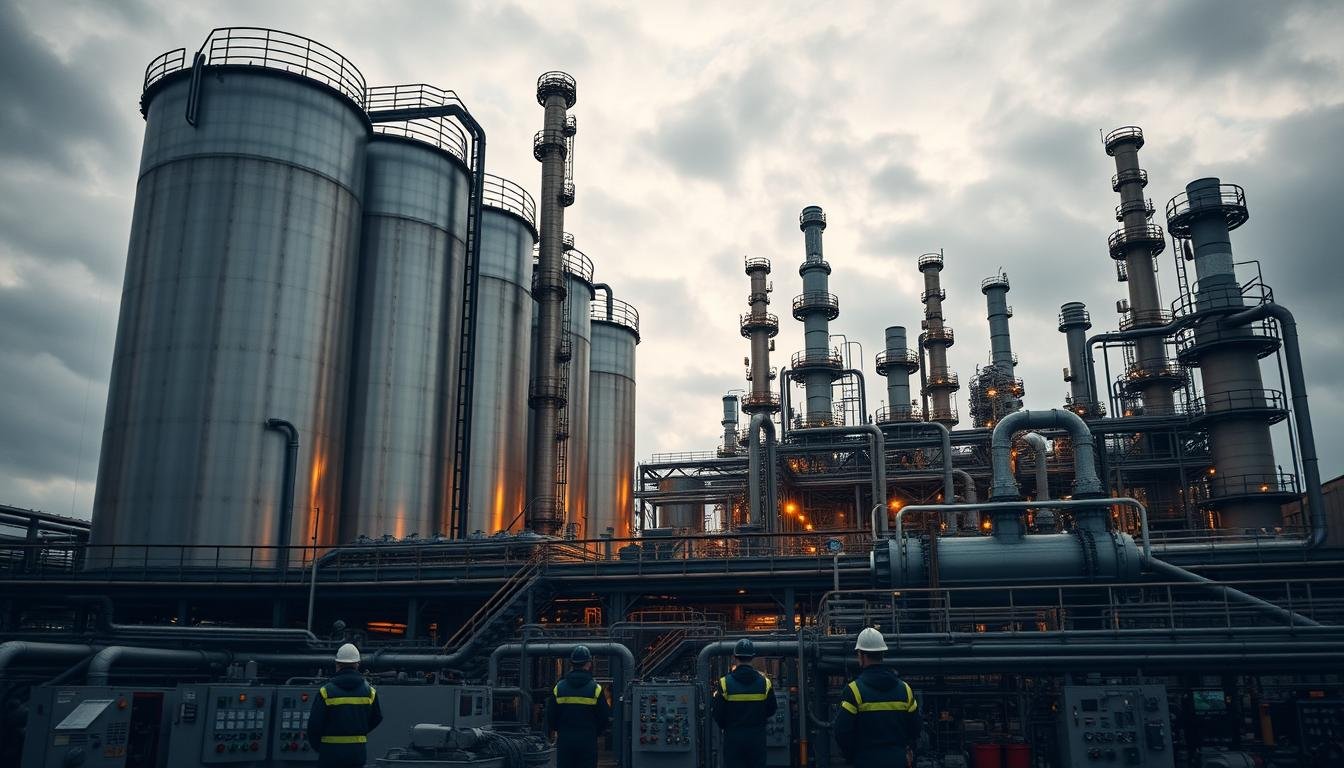In this detailed PDF, I explore the complex world of crude oil processing. It’s a guide for anyone wanting to know more about turning crude oil into useful products. You’ll learn about different oil processing methods, refining steps, and their effects on the environment.
Crude oil is key to the global economy and energy production. This PDF is packed with important information for both experts and those curious about the subject.
Understanding the Basics of Crude Oil Processing:
Crude oil is a mix of hydrocarbons, which are made of hydrogen and carbon atoms. It’s important to know what makes up crude oil. This includes paraffins, naphthenes, and aromatics. Each one affects how petroleum is processed and used.
These hydrocarbons have unique properties. For example, paraffins have a lot of energy. Aromatics, on the other hand, impact the quality of petroleum products. Knowing this helps us understand how oil is refined.
Many techniques are used to separate and refine these hydrocarbons. This is key to the oil industry’s success. Understanding crude oil composition helps improve these processes. It also supports the need for cleaner and more efficient petroleum products.
Crude Oil Distillation Techniques:
Crude oil distillation is key in separating different parts of oil based on boiling points. We use two main methods: atmospheric and vacuum distillation. Atmospheric distillation works under normal pressure, separating lighter parts like gasoline and kerosene from heavier ones like diesel and lubricants.
Vacuum distillation, on the other hand, works under lower pressure. It helps get more valuable products from the heavier parts of oil. This method also keeps the oil’s components from breaking down too much. Using both methods helps refine oil better, making the process more efficient.
New technologies in distillation have really changed the game. Better designs and energy-saving systems have improved how we separate oil. These advancements are important for refining oil in a way that’s good for the environment.
Crude Oil Refining Processes:
In my exploration of crude oil refining, I’ve found key methods that turn crude oil into valuable products. Hydrocracking is a major technique that breaks down heavy hydrocarbons into lighter, more useful fractions. This is key for improving the quality of diesel and gasoline, boosting yield and efficiency.
Catalytic reforming is another vital method. It changes low-octane naphthas into high-octane gasoline components. This is essential for meeting today’s fuel standards. The use of catalysts in this process not only enhances gasoline quality but also increases the output of valuable products.
Looking at these refining technologies, it’s clear how they affect the complexity and efficiency of crude oil processing. The combination of hydrocracking and catalytic reforming forms a complex system. This system supports the production of many petroleum products, including lubricating oils. This shows the critical role these processes play in the industry, backed by technical publications and standards from groups like the Society of Petroleum Engineers.
Environmental Impact of Crude Oil Processing:
The way crude oil is processed has a big impact on the environment. It leads to pollution in the air and water. This pollution harms both the air we breathe and the water we drink.
Studies by the Environmental Protection Agency show the damage done by crude oil. The carbon emissions from these activities are huge. This points to the oil industry’s role in climate change. We need to find ways to make these processes cleaner and safer for our planet.
The Future of Crude Oil Processing:
Looking ahead, the future of oil processing is set for big changes. New technologies and a move to renewable energy are leading the way. The industry is adopting new methods that make it more efficient and sustainable.
Organizations like the International Energy Agency are guiding us toward a greener future. They offer insights that help shape the industry’s direction.
Digitalization and automation are key to these changes. They make operations smoother and cut down on mistakes. By using advanced data and machine learning, companies can refine better and use less energy.
These tech advancements are essential for the oil industry’s future. They meet both operational and environmental needs.
There’s also a push for sustainable refining methods. As companies aim for lower carbon emissions, they’re investing in cleaner products. This shift prepares the oil industry to work alongside renewable energy.
This change marks a big turning point for oil processing. It shows the industry’s commitment to a sustainable future.
